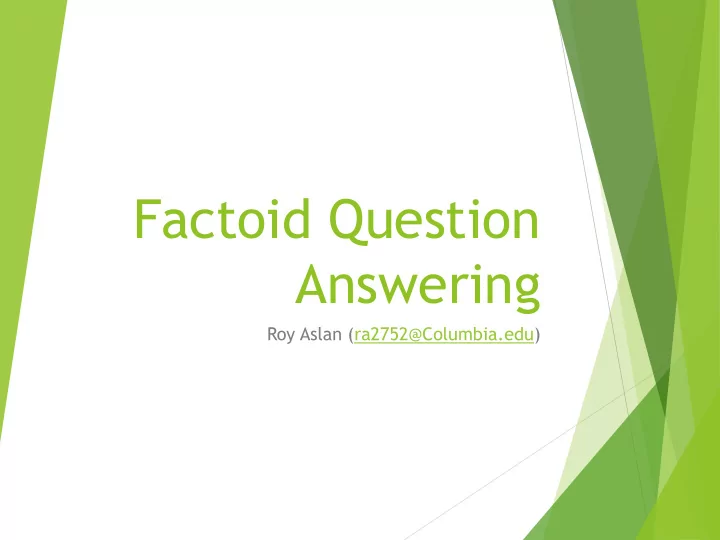

Factoid Question Answering Roy Aslan (ra2752@Columbia.edu)
A Neural Network for Factoid Question Answering over Paragraphs Mohit Iyyer, Jordan Boyd-Graber, Leonardo Claudino, Richard Socher, and Hal Daumé III
Task and Setting Factoid question answer Quiz Bowl dataset Multi sentence “question” mapped to entity as the “answer” Questions exhibit pyramidality: initial sentences are more subtle (e.g., few named entities)
Contributions Bag of words representation relies on indicative named entities Paragraph (versus sentence) length inputs Proposed dependency-tree recursive NN (DT-RNN) model exploits semantic/compositional information Previous work used DT-RNN to map text descriptions to images Here question/answer representations can be learned in same vector space Robust to varying syntax (same question can be asked in a variety of ways)
Model illustration in next slide
Input: Leaf hidden vector: Word2vec x to h mtrx tanh (mikolov) Internal node hidden vector: Dependency relation 1 for each 46 mtrx relations Root node: General formula for node: Dependents
Training Questions and answers trained in same vector space Want question sentences near answers and far from incorrect answers Given a question sentence and correct answer pair, select j incorrect answers
Training Random set of (100) wrong Node in Correct answers answer DT Sentence error: parameters Rank estimator: (sample K till violation) Rank loss: Error over all T sentences and N nodes: Back propagation:
Experiments About 10k quiz bowl question mapped to about 1k answers About a dozen training examples per answer (minimum 6) Number of random wrong answers set to 100 All parameters randomly initialized (except preprocessed word2vec vectors) Trans sentential averaging Concatenate and average node representations to form sentence representation Average representations of all sentences in question (paragraph) Question representation is fed into logistic regression classifier for answer prediction
Results – vs baselines Pos 1 and Pos 2 means at first/second sentence position within question
Results – vs human Each bar represents individual human player
Semantic Parsing for Single- Relation Question Answering Wen-tau Yih, Xiaodong He, and Christopher Meek
Task and Setting Answering single relation factual questions “Who is the CEO of Tesla ?” “Who founded Paypal ?” Multi relation questions are out of scope “When was the child of the former Secretary of State in Obama’s administration born?”
Contribution Novel dual semantic similarity model using CNN Map entity mention to entity in KB Map relation pattern to relation “When were DVD players invented?” Entity mentioned: dvd-players Relation: be-invent-in
Model in Next Slide
Latent semantic representation V(i) is max of h(i) among 1 <= t <= T Tease out most salient local features n-gram context window Letter trigram count vectors
Training Two models are trained from Pattern-relation pairs Mention-entity pairs 100 randomly selected negative examples Softmax based on cosine similarity used for calculating probability of correct relation given an input Maximize log probability using SGD
Experiments PARALEX dataset Derived 1.2M patterns-relation pairs with argument position for answer 160K mention-entity pairs Context windows size set to 3 Question evaluation: Compute top 150 relation candidates for pattern (based on similarity score) For each candidate, compute mention and argument entity similarity (among KB triplets with this relation) Product of the pattern-relation and mention-argument probabilities (softmax based on cosine) is used as final ranking Predefined threshold to establish precision-recall trade-off
Results Full model Surface level mention- Baseline entity similarity Gap at higher recall
Results - examples
Questions? Go back to beginning for first paper
Recommend
More recommend